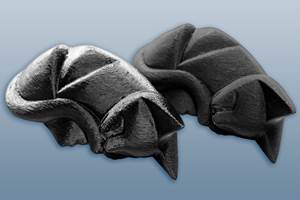‘Lean’ Molding & Liquid Color: A Good Fit
If you want to take up parasailing, it’s probably best that you have no fear of heights.
If you want to take up parasailing, it’s probably best that you have no fear of heights. If you want to go where few if any large-part blow molders have gone before, it’s probably best if you have no fear of failure.
Such was the mindset of Hayward Pool Products, Clemmons, N.C., which injection and blow molds a wide range of pool products. In 2008, the molder switched from using pellet concentrates to liquid colors on three large blow molding machines producing housings for filter tanks, a move considered risky by most blow molding pundits.
The switch to liquid color, supplied by Riverdale Color Co., Perth Amboy, N.J. (riverdalecolor.com), is among the more recent changes made by Hayward as part of an ongoing process that started in the late 1990s to streamline its manufacturing processes. “Before 1999, we were a typical U.S. manufacturer,” remarks Scott Pugh, Hayward’s heat-pump and filter manufacturing manager. “Production was not tied to demand. We were overproducing, had inventory everywhere, and needed more space just for storage.”
Hayward worked with consultants and in late ’99 revamped its operation to incorporate “lean” manufacturing techniques advanced by the likes of Toyota years before. To go lean, Hayward had to revamp its processing operation entirely—no small feat when you consider the thousands of different parts of all sizes it molds and welds. Gone were the long assembly lines, replaced by U-shaped manufacturing cells where components are injection and blow molded and assembled into complete parts by one operator.
The desire to produce products on demand and reduce inventory also encouraged Hayward to replace more traditional dry colorants with liquid. “As we went lean, we had to make shorter runs of multiple products, and respond quickly to demand,” Pugh explains. “With dry color, the time it took us to change over was posing a huge problem. We’re talking about cleaning a huge accumulator head weighing 50,000 lb. You can’t take it apart, material tends to hang in there, and it was taking us up to 25 hr just to switch from one color to another.”
As part of its continuous-improvement initiative, Hayward assembled a project team to look at every aspect of the problem…more than once. “Our culture encourages us to try things and not be afraid of failure,” states Pugh. “We knew that in order to even try to run liquid, for example, we had to rebuild our screws, which cost us $70,000 on the three blow molders. But we made the investment before we even had an inclination of the result.”
After several trials, involving multiple liquid-color vendors, different formulations, and machine modifications, Hayward went with Riverdale’s Pump-in-a- Drum liquid color system combined with a weigh-scale blender furnished by Riverdale sister company Maguire Products, Aston, Pa. (maguire.com). Pugh summarizes the benefits:
- Huge reductions in scrap due to color changes. A black-to-platinum switch used to take 300 parts to finish. Now it takes fewer than 20.
- Faster changeovers, resulting in lower inventories yet improved customer deliveries.
- Elimination of landfill-bound purgings.
- Lower storage space requirements than for pellet colorants.
- Reduced cycle times.
- Ability to reuse liquid containers.
- Reduction in regrind fines.
“It took persistence to bring liquid color use to fruition at Hayward,” Pugh says. “A culture of continuous improvement provided us with a foundation to move forward.” Pugh says the results have been so impressive that Hayward is mulling a move to liquid for injection molding as well.
Related Content
Compatibilizer for Nylon/ABS Alloys
CAI Performance Additives’ ST-AN3230 has shown to improve both compatibility and performance of nylon/ABS alloys.
Read MoreTosaf’s Investments in North America Result in 40% Increase in Production Capacity
Backed by a global presence, Tosaf provides localized additive and color solutions, and services for the plastic industry in North America.
Read MoreK 2022 Additives & Materials: Sustainability in the Lead
Nearly all of the new additives highlighted at the big show are aimed at enhancing recyclability of commodity resins and some volume engineering resins such as nylon and PC. A few new materials, on which we had not previously reported, also surfaced at K 2022.
Read MoreMasterbatches Reduce Gloss in PLA and PETG 3D Printed Products
Insight Polymers & Compounding’s two low-gloss additive masterbatches shown to boost appearance of 3D printed objects.
Read MoreRead Next
For PLASTICS' CEO Seaholm, NPE to Shine Light on Sustainability Successes
With advocacy, communication and sustainability as three main pillars, Seaholm leads a trade association to NPE that ‘is more active today than we have ever been.’
Read MoreMaking the Circular Economy a Reality
Driven by brand owner demands and new worldwide legislation, the entire supply chain is working toward the shift to circularity, with some evidence the circular economy has already begun.
Read More




















